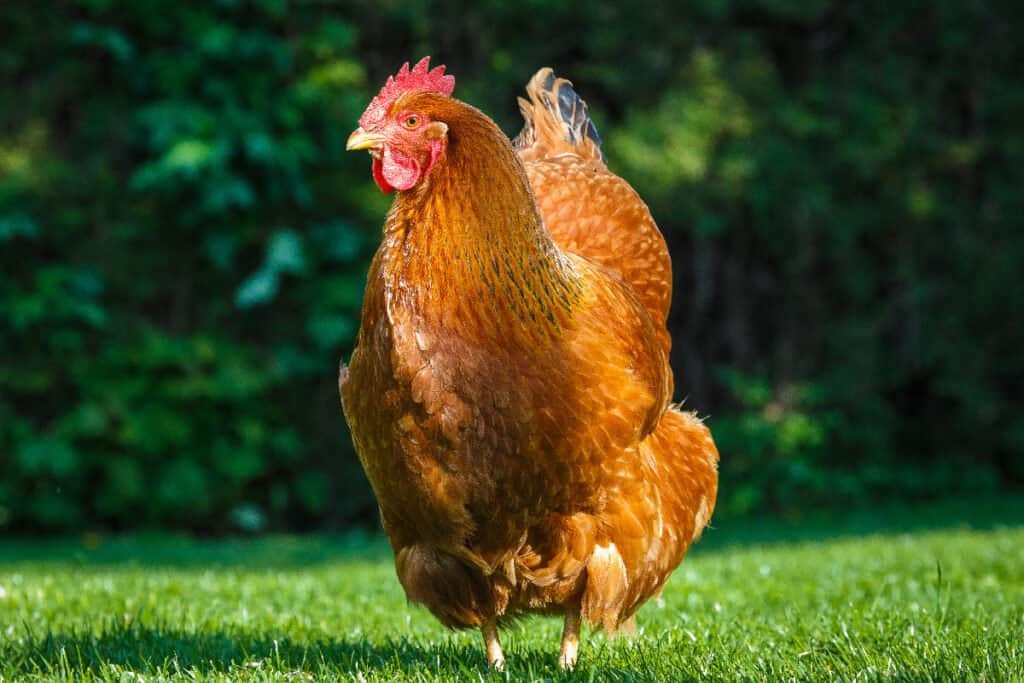New Hampshire Red Chicken
Gallus gallus domesticus
New Hampshire reds are known for being quite food aggressive towards other chickens and won't hesitate to push other flock mates out of the way to get to the feed.
Advertisement
New Hampshire Red Chicken Scientific Classification
- Kingdom
- Animalia
- Phylum
- Chordata
- Class
- Aves
- Order
- Galliformes
- Family
- Phasianidae
- Genus
- Gallus
- Scientific Name
- Gallus gallus domesticus
Read our Complete Guide to Classification of Animals.
New Hampshire Red Chicken Conservation Status
New Hampshire Red Chicken Facts
- Name Of Young
- Chicks
- Group Behavior
- Flock
- Fun Fact
- New Hampshire reds are known for being quite food aggressive towards other chickens and won't hesitate to push other flock mates out of the way to get to the feed.
- Most Distinctive Feature
- Reddish coloring
- Incubation Period
- 21 days
- Predators
- Foxes, wolves, mountain lions, weasels, opossums, and dogs
- Diet
- Omnivore
- Lifestyle
- Diurnal
- Common Name
- New Hampshire Red
- Origin
- New Hampshire and Massachusetts
New Hampshire Red Chicken Physical Characteristics
- Color
- Red
- Light-Brown
- Skin Type
- Feathers
- Lifespan
- 7 to 8 years
- Weight
- 6.5 to 8.5 pounds
- Age of Sexual Maturity
- 18-22 weeks
- Aggression
- Medium
View all of the New Hampshire Red Chicken images!
New Hampshire red chickens may look similar to the Rhode Island red, but they never received the same success. The latter completely outshined the New Hamshire red despite these two breeds being created a few years apart. It’s a pity because these chickens have a lot to offer any home because of the hen’s true dual-purpose abilities.
New Hampshire Red History
The New Hampshire red chicken was first created less than 100 years ago. They were first developed in New Hampshire and Massachusetts as an alternative to the Rhode Island red. Breeders wanted to invent a breed that would:
- Grow faster
- Mature quicker
- Feather faster
- Produce more eggs
- Produce more meat
So, in 1910, poultry breeders decided to crossbreed several Rhode Island red strains and eventually stumbled upon the New Hampshire red. Professor Richardson was credited for creating this breed while working at an agricultural experimentation station. During this time, popular chicken contests were circulating throughout America called “The Chicken of Tomorrow,” which is how they started to promote the New Hampshire red breed. In addition, a documentary with the same name was produced in 1948 to inform the public about the vast improvements being made to the chicken industry. Unfortunately, the New Hampshire red didn’t win the competition but did become one of the initial breeds to create the broiler industry. Furthermore, they were one of the breeds used to develop the Delaware chicken, another short-lived celebrity of the broiler industry.
New Hampshire Red Amazing Facts
- These chickens are robust and reliable, as they can live in almost any climate. Their ability to tolerate cold temperatures is impressive, and they are usually found outside foraging in the snow while other breeds are cuddled up together in the coop.
- There are two types of New Hampshire reds, standard, and bantam (miniature)
- New Hampshire red roosters can be aggressive
New Hampshire Red Scientific Name
The New Hampshire red chicken’s scientific name is Gallus gallus domesticus, and they form part of the order Galliformes. This order contains 290 species like turkeys, guinea fowl, partridges, pheasants, quail, and peacocks.
New Hampshire reds are members of the form part of the Phasianidae family, which consists of 185 species and 54 genera.
New Hampshire Red Size, Appearance & Behavior

New Hampshire red chickens weigh between 6.5 to 8.5 pounds.
©Jesper Frehr/Shutterstock.com
These chickens have ravishing chestnut red or golden red feathers. Additionally, they have a few black feathers in their tails, and the hen’s neck feathers are sometimes tipped in black. Furthermore, New Hampshire red chickens have large wattles, medium combs, and long red earlobes. The rooster‘s single comb is erect, while the rear of the hen’s comb can flop to the side. They have yellow beaks adorned with a red horn, red eyes, and yellow legs. However, their appearance changes before and after annual molts. Once their new plumage grows in, their feathers have a glowing reddish-brown color, which they are notorious for. But, after a few months of being outdoors and laying eggs, their feathers start to fade to a lighter shade that can appear patchy.
New Hampshire red chickens come in two forms; standard and bantam (miniature). Therefore the size and weight can differ significantly. For example, standard hens weigh approximately 6.5 pounds, and roosters weigh around 8.5 pounds. However, bantam hens weigh 30 ounces, while bantam roosters weigh 34 ounces.
Behavior
New Hampshire reds are broody chickens and will sit on their eggs to help them hatch; they also make amazing mothers. Some hens will even sit on other breeds’ eggs, but this will differ on individual preference. Additionally, these chickens are easy to tame and make excellent family pets. However, they are known for being quite food aggressive towards other chickens and won’t hesitate to push other flock mates out of the way to get to the feed. This behavior will not bode well if you have other shy or docile breeds. But you can prevent or limit this bad behavior by installing several feeding stations spread apart from each other. Unfortunately, it’s hard to predict their personalities as they vary so much as they can be loveable and friendly or moody and aggressive.
New Hampshire Red Chicken Diet
If you have New Hampshire red chicks under 6 weeks old, you must provide them mashed feed with a high protein content of at least 19%; it is also easily ingested because it’s refined. Once they reach six weeks old, you can switch to pellet feed that contains at least 15% to 16% of protein. When they near egg production age at 18 weeks, they will need more nutrients, so along with their regular feed, add some oyster shells, which contain a lot of calcium.
Owners need to provide their New Hampshire reds with fresh water daily. However, these chickens prefer cool drinking water, so try to place the containers in the shade.
New Hampshire Red Predators and Threats
These chickens are predator savvy, but because they are not very good flyers, it is hard for them to make a quick escape. But luckily, most of the New Hampshire red chicken’s predators are nocturnal, so by keeping them in a secure coop overnight, you can successfully prevent most attacks. Predators include:
- Wolves
- Raccoons
- Opossums
- Foxes
- Dogs
- Mountain lions
- Weasels
New Hampshire Red Reproduction, Eggs, and Lifespan
If you want to breed with these chickens, all you have to do is add a rooster to the flock, and he will mate with various hens and fertilize their eggs. However, if you are raising these chickens to sell eggs, never have a rooster among the hens.
Eggs
The New Hampshire red chicken is a good egg layer and meat producer. They can lay up to 200 large eggs annually. Their eggs are light brown in color, and you can expect around one to three eggs weekly per hen. Unlike most chicken breeds, New Hampshire hens produce more eggs during colder months.
These hens often go broody; they are good setters and fantastic mothers. Sometimes when New Hampshire red hens go broody, they will eagerly incubate other breeds’ eggs.
Lifespan
The average lifespan of a New Hampshire red is between 7 to 8 years old.
New Hampshire Red Population
While these chickens aren’t critically endangered, they are very rare. In fact, the Livestock Conservancy has given them the conservation status of “Watch.” There is no definitive data about their population size, but if one thing is clear, it is on the decline.
The Difference Between Rhode Island Reds and New Hampshire Red Chickens
There are very minor differences between these two breeds, but their most distinguishing features are as follows:
- Rhode Island reds have broader bodies compared to New Hampshire reds, who are more slender.
- The New Hampshire reds are more docile than the Rhode Island reds
- Rhode Island reds have a true mahogany color, while the New Hampshire reds are lighter in color.
Up Next
View all 65 animals that start with NNew Hampshire Red Chicken FAQs (Frequently Asked Questions)
Are New Hampshire Red chickens good egg layers?
The New Hampshire red chicken is a good egg layer and meat producer. They can lay up to 200 large eggs annually.
What is the difference between a Rhode Island Red and a New Hampshire Red chicken?
- Rhode Island reds have broader bodies compared to New Hampshire reds, who are more slender.
- The New Hampshire reds are more docile than the Rhode Island reds.
- Rhode Island reds have a true mahogany color, while the New Hampshire reds are lighter in color.
What color eggs do New Hampshire Red chickens lay?
Their eggs are light brown in color, and you can expect around one to three eggs weekly per hen.
Thank you for reading! Have some feedback for us? Contact the AZ Animals editorial team.
Sources
- Chicken Scratch, Available here: https://cs-tf.com/new-hampshire-chicken/
- Poultry Pages, Available here: https://www.poultrypages.com/new-hampshire-red-chicken/
- Happy Chicken Coop, Available here: https://www.thehappychickencoop.com/new-hampshire-chicken/

















